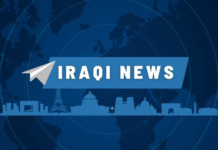Tishwash: in IRaq’s news
Will the BRICS+ group of countries change the world?
Brazil, Russia, India, China and South Africa (emerging market economies known as BRICS) accounted for 19% of global GDP on a purchasing power parity basis in 2001 .
Currently, the share that includes countries scheduled to join the bloc is 36%, and the percentage is expected to rise to 45% by 2040, more than double the share of the economies of the Group of Seven major advanced industrial countries .
The rapid rise of the BRICS group is changing the global economy. Member states generally have less democracy and freedom than advanced economies, and growing economic weight could result in a massive shift in influence. Despite this, the bloc lacks homogeneity, which will stand in the way of the ambitious goals of some of the group’s countries, such as competing with the US dollar for its dominant role globally .

The name BRICS began when Jim O’Neill, the chief economist at Goldman Sachs at the time, set two criteria for membership, the first of which was that countries must have a truly large economy and be prepared to grow rapidly. Brazil, Russia, India and China came to the fore. In an added bonus, the first letters of the names of these countries represent an abbreviation for the attractive bloc .
The idea proved to be hugely successful. The original BRICS group achieved remarkable growth during the first decade of this century. In an unusual example from a geopolitical standpoint, they united to form a bloc, which South Africa joined in 2010, based on a recommendation contained in a research note from a Wall Street bank .
During August of this year, the BRICS group invited 6 other countries to join the bloc: Argentina, Egypt, Ethiopia, Iran, the Kingdom of Saudi Arabia, and the United Arab Emirates .
There is no new abbreviation for the economic group’s name, but the name will likely be changed to BRICS +. Those joining the group also expand O’Neill’s original membership criteria, but there remain other, more qualified candidates outside the bloc .
Indonesia, for example, has not yet joined the BRICS+ group, but its economy is larger than Egypt, Saudi Arabia, and the United Arab Emirates, and it is likely to outgrow two of the three countries. Nigeria and Thailand both outperformed Iran on O’Neill’s two criteria. Mexico and Turkey are ahead of Argentina. The same applies to Bangladesh when compared with Ethiopia .
The meaning is clear. The expansion of BRICS is less about economics and more about politics. As for the engines of expansion, it is related to challenging the hegemony of the United States of America, getting rid of the dollar as the main currency in the world, and establishing alternative institutions to the International Monetary Fund and the World Bank, whose headquarters are located in Washington .
Can the BRICS group achieve this goal? The group has several advantages: size, diversity and ambition .
First, the enlarged BRICS is actually larger than the Group of Seven major industrialized nations, which includes Canada, France, Germany, Italy, Japan, the United Kingdom, and the United States of America. During 2022, the bloc represented 36% of the global economy, compared to 30% for the group of economically developed countries. Our projections indicate that the expanding workforce and huge scope for technological catch-up will expand the BRICS+ share to 45% by 2040, compared to 21% for the G7 economies. In practice, BRICS+ and the G7 will exchange positions in relative size until 2040. Enjoying economic weight will also mean enjoying political influence .
Second, the bloc’s membership will include some of the world’s largest oil exporters (Saudi Arabia, Russia, the United Arab Emirates, and Iran) and some of its largest importers (China and India). If the adoption of currencies other than the dollar to settle some oil deals succeeds, this may indirectly affect the US currency’s share of international trade and global foreign exchange reserves .
Third, it has become clear that weakening the dollar’s dominance is one of the ambitions of BRICS+. China has sought greatly to strengthen the role of the yuan in global trade. Brazilian President Luiz Inacio Lula da Silva called on the bloc to find an alternative to the US dollar, while Russia believes that directing the economic reorganization process towards China and away from Europe constitutes the only rational option as it continues its war on Ukraine. Because of the sanctions, Moscow actually sells oil to China in yuan .
However, looking deeper than the surface, BRICS+ also faces some challenges ahead .
BRICS+ is already big and growing; But China’s debt problem and a corrective movement in the property market mean that one of the group’s main drivers is dissipating. The bloc’s emergence over the current century is largely due to the story of Beijing’s astonishing economic growth at an average of 9% per year during the period 2000-2019. This rate is likely to decline to 4.5% during the 2020s, 3% in the 1930s, and 2% in the fourth decade. India may also suffer from some recession, but its economic rise and political ambition are unlikely to match those of China .
BRICS includes oil exporting and oil importing countries as members, but some of them conduct oil deals in US dollars. Producing countries Saudi Arabia and the United Arab Emirates peg their currencies to the dollar and need US currency reserves to support their financial positions. Even without a peg, the majority of countries – unless they are subject to sanctions such as Iran or Russia – prefer payments in dollars as the most acceptable trading medium in international trade .
There is hesitation in the BRICS group of countries to promote an alternative currency. Russia does not want to obtain the rupee from India in exchange for its oil, because it does not want to accumulate its savings in India. But what if India makes payments to Russia in Chinese yuan? Here the geopolitical competition between New Delhi and Beijing emerges. As the former will not want to promote the use of the Chinese yuan in global trade .
Finally, the enlarged bloc lacks consensus and cohesion; India is suffering from a renewed border dispute with China. Tensions may worsen as India rises and China declines .
Saudi Arabia and Iran recently resumed diplomatic relations. But a deep division resulting from proxy wars may require difficulty to bridge. New Delhi and Riyadh also signed – along with the UAE – a memorandum of understanding with the United States of America and Europe to establish an economic corridor that competes with China’s “Belt and Road” initiative .
What about alternative institutions to the International Monetary Fund and the World Bank? Again, this will likely remain more of an aspiration than a reality. The New Development Bank, the BRICS affiliate similar to the World Bank, spent a small amount of money. The BRICS emergency reserve arrangement mechanism, which is supposed to be a competitor to the IMF, is small and of limited use .
The idea of a single BRICS currency, with a unified monetary policy, seems unlikely, especially at the present time. Brazil cuts interest rates while Russia raises them sharply; While the UAE and Saudi Arabia mimic everything that the US Federal Reserve does. When we see the Eurozone facing difficulties in light of a unified currency and monetary policy, the BRICS group of countries may not be able to find a unified currency according to the “one size for all” rule from the beginning .
This does not mean that the surprising rise of the BRICS group will be without repercussions on the global economy. The center of gravity will shift to the east and south, where governments enjoy low levels of democracy, popular representation, and intervene more in markets compared to the West .
Within the BRICS+ group of countries, only Argentina, Brazil and South Africa were rated “free” by Freedom House last year. India was described as “partly free,” while China, Egypt, Ethiopia, Iran, Russia, Saudi Arabia, and the UAE were described as “not free.” When we measure the contribution to global GDP from countries classified as “partly free” or “not free,” we find that it has increased from 24% in 1990 to 49% in 2022. Our expectations indicate that this percentage will increase to 62% by 2040 .
Things look even bleaker for advocates of liberal markets. The Heritage Foundation, a conservative US think tank, rates almost all BRICS+ economies as “mostly unfree” or worse. While the economies of the Group of Seven major industrialized nations were classified as “mostly free” or “relatively free .”
But the contribution to global GDP by economies classified by the Heritage Foundation as “mostly unfree” or “repressed” actually jumped from 27% in 1995 to 44% in 2022, and by 2040 our expectations indicate that it will rise to 56%. %.
The BRICS group of countries will change the world, but this may be due more to their growing share of GDP and diverging political and economic systems than to fulfill the grand plans of their decision-makers link






